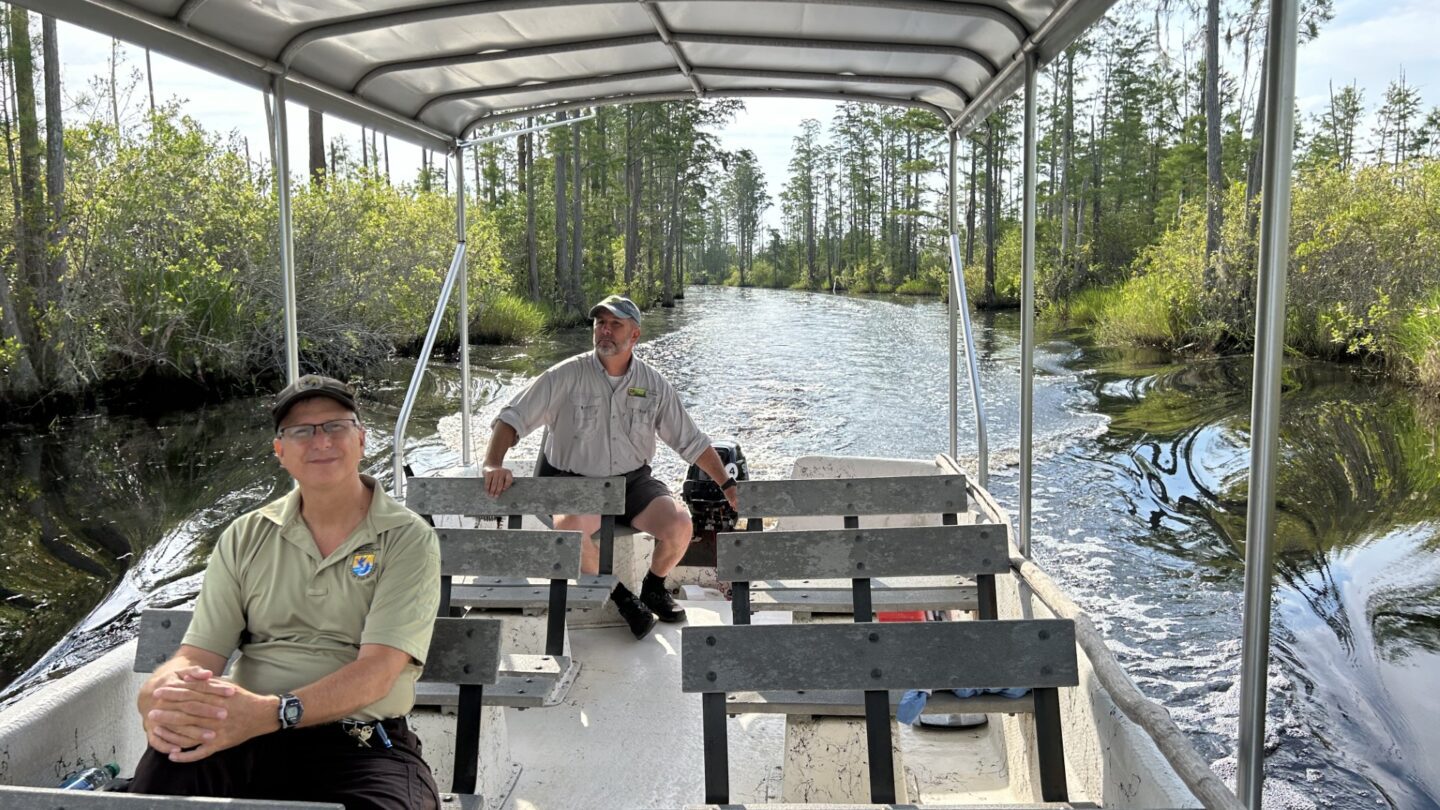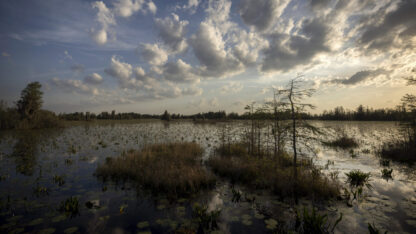Matt Rouse drives a 24-foot jon boat through the cypress-shaded canals of the Okefenokee Swamp. Its rows of chairs have welcomed tourists from the west coast to Germany. He says it’s because those visitors are surrounded by something truly unique.
“We are entering the largest completely freshwater swamp in North America,” Rouse said.
The Okefenokee National Wildlife Refuge, which covers over 400,000 acres, or 600 square miles, is currently in the running to become a UNESCO World Heritage Site.
“You almost have to go to the Amazon basin in South America to find a place this big with this kind of biodiversity,” Rouse said.
Which is why he and many others are worried about what may be coming: Twin Pines Minerals, LLC proposed a titanium dioxide mine right at the edge of the swamp. The mineral is mostly used to whiten products, like toothpaste or the cream in Oreos.
Since the initial proposal in 2019, opponents have been in an uproar. There have been two pieces of legislation that failed to pass, two protest songs, social media recognition from Leonardo Di Caprio and over 70,000 public comments to the Georgia Environmental Protection Division (EPD) — the most the agency has ever received on a single project.
The federal government, which once would have had oversight over the proposed project, has searched for ways to reinsert itself as regulatory rollbacks and court decisions have shrunk its reach.
Now, the U.S. Fish and Wildlife Service is using federal reserved water rights, a tool it has never used before in the eastern U.S. to try to prevent the mine. It’s a move that could become more common as climate change and development lead to more clashes over water rights.
Rollbacks affect water protections
In February, the Georgia EPD issued the draft permits for the mine. The next step is the final approval Twin Pines needs to start building and operating, though the state has not set a timeline for when it will issue final permits.
Experts say just a few years ago Georgia wouldn’t have been in this position.
Trump-era rollbacks of federal water protections and a U.S. Supreme Court case last year have scaled back federal oversight of projects like Twin Pines’ mine, according to Megan Huynh, an attorney for the Southern Environmental Law Center.
“Twin Pines first applied for these permits back in 2019 — at the time, they were applying not just for state permits, but also for a federal Clean Water Act permit,” Huynh said.
She said at that point, nearly half of the proposed mining site — which is about three miles from the national wildlife refuge — was federally protected.
But after those changes, none of the site fell under federal protections, Huynh said. Twin Pines was able to forgo any federal Clean Water permits, which entail more thorough environmental reviews.
As a result, the Georgia EPD is permitting one of its first controversial and technically challenging wetlands projects without the applicant passing federal muster first.
Twin Pines has said that according to its own scientific modeling, the mine doesn’t pose a threat to the swamp. The state of Georgia has accepted those findings.
Because of the changes in federal law, the U.S. Fish and Wildlife Service, which manages the country’s wildlife refuges, does not have any special power in the permitting process for the mine. The agency’s experts can only show up and submit public comments like anyone else.
“That really took away a lot of the federal nexus that we as the Fish and Wildlife Service would have looked to to be able to comment on permits,” said Michael Lusk, refuge manager at the Okefenokee National Wildlife Refuge.
Lusk, who’s been representing the U.S. Fish and Wildlife Service through public comments to the Georgia EPD, said he feels that the state agency hasn’t sufficiently addressed his agency’s concerns.
National Parks Service (NPS) hydrologists did their own modeling of Twin Pines’ plans on behalf of Fish and Wildlife, and they didn’t agree with Georgia’s assessment that there was no risk to the swamp.
“They did not believe that the model was sufficient to accurately predict the effects of the mine on drought on the Okefenokee,” Lusk said.
In a detailed document to the Georgia EPD, the NPS hydrologists laid out a list of nine “critical shortcomings” they found in the model.
So, Lusk said, Fish and Wildlife is turning to federal reserved water rights.
Federal reserved water rights
According to Georgia State University law professor Ryan Rowberry, federal reserved water rights is a doctrine that gives the federal government the right to the water it needs to operate a federally reserved land, such as a national park, monument or refuge.
Those federal properties are made with specific purposes, whether it’s to conserve an ecosystem or provide public recreation spaces.
Rowberry said this is pretty common in the western U.S., where water is carefully parceled out through interstate agreements. Historically, Fish and Wildlife has used this tool at places like Zion and Yellowstone national parks.
Rowberry said that Georgia and Fish and Wildlife will need to determine what quantity of water the Okefenokee National Wildlife Refuge actually needs in order to figure out how federal reserved water rights can be fulfilled. If the mine permits are issued first, the federal agency can sue, he said.
And, Rowberry said, this move could have big consequences.
“I think this is a bellwether for the rest of the eastern United States really,” he said. “It could have a huge impact among all other federal reservations in the East.”
This isn’t the first time the federal government has flirted with using federal reserved water rights in the East, Rowberry said, and if it was not claimed at the Okefenokee Swamp it would have only been a matter of time until the government used it elsewhere. Especially as climate change and development patterns challenge the idea that water is plentiful in the East, Rowberry said this type of conflict over water is likely to become increasingly common.
Lewis Jones, an attorney for Twin Pines called Fish and Wildlife’s declaration of federal reserved water rights “a publicity stunt with no future as an actual legal claim.”
A spokesperson for Jones wrote in an email to WABE that the hydrologist the company had hired concluded that the mine would not impact the swamp, and thus, federal water rights are not implicated.
“But any legal claim would fail even if the facts were different, because ‘reserved water rights’ do not exist in Georgia; the Okefenokee National Wildlife Refuge is not a ‘federal reservation’ for which such water rights could have been reserved, if they existed in this state,” a spokesperson wrote on Jones’ behalf.
A delicate balance
Lusk said the Okefenokee is highly drought prone, as is the St. Mary’s River, which flows out of the swamp. Water levels in the swamp are naturally only one to three feet deep at any point. In his time as refuge manager, he’s seen the swamp and the refuge’s staff through major events like the 2017 West Mims Wildfire that scorched tens of thousands of acres.
Still, though he’s seen the scales teeter, Lusk said the Okefenokee Swamp is a functioning – but delicate – balanced system.
“The fact that it’s an entire fully functioning ecosystem on a gigantic scale is what makes it unique,” Lusk said.
He contrasted that to places like the Everglades, which has had major ecosystem and hydrological disruption that helped invasive species take root, from small plants to giant pythons. For Lusk, the Everglades have become a cautionary tale.
“They have been ditched, drained and diked to an extreme extent. And so now the American taxpayer is paying literally billions of dollars to try to fix the hydrology,” Lusk said.
And a mine, he said, could open the door to that destruction in the Okefenokee.









